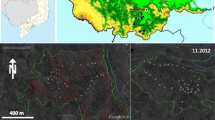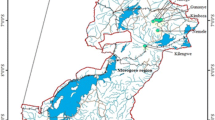Abstract
The Amazon contains some of the most critical ecosystems on earth and Igapó forests are one of those ecosystems. They are flooded by “black-water”, leached runoff of forest litter. To help in our understanding of igapó forests, and to act as a resource for their future research, I review what we know about their composition and structure. I used my own sampling data to construct floristics tables of the tree species, and tables of physical structural parameters such as tree density, species richness basal area and above-ground biomass (AGB). In addition I used data gotten from literature searches on google scholar, biosys, WorldCat discovery services and other databases for all papers that sampled trees in plots within igapó forests. I found there was a total of 59 families sampled in all the plots. The families with the most genera were Fabaceae and Caesalpiniaceae, with the most species were Fabaceae and Euphorbiaceae, and with the most tree stems were Fabaceae and Euphorbiaceae. The most common genera were Mouriri and Lincania and the most common species were Virola elongate and Swartzia polyphylla. For structure, total stems had a wide range between 167 and 683 per ha, stem sizes generally conformed to a “reverse J” distribution pattern, mean stem sizes were ~20 cm diameter at breast height, there was a species richness range between 90 and 119 per ha, and igapó forests were more open than other forest-types in the Amazon basin. While these plots were in primary igapó forest, my samplings of secondary igapó forests showed they had a reduced structure compared to primary igapó forests but were similar within the different kinds of secondary igapó forests.
Resumen
El Amazonas contiene algunos de los ecosistemas más críticos de la tierra y los bosques de Igapó son uno de esos ecosistemas. Están inundados por “aguas negras”, escorrentías lixiviadas de la basura forestal. Para ayudar en nuestra comprensión de los bosques de igapó, y para actuar como un recurso para su futura investigación, repaso lo que sabemos sobre su composición y estructura. Utilicé mis propios datos de muestreo para construir tablas florísticas de las especies arbóreas y tablas de parámetros estructurales físicos tales como la densidad del árbol, el área basal de la riqueza de especies y la biomasa aérea (AGB). Además, utilicé datos obtenidos de búsquedas bibliográficas en Google scholar, biosys, servicios de descubrimiento WorldCat y otras bases de datos para todos los documentos que muestreaban árboles en parcelas dentro de los bosques de igapó. Encontré que había un total de 59 familias muestreadas en todas las parcelas. Las familias con más géneros fueron Fabaceae y Caesalpiniaceae, con la mayoría de las especies Fabaceae y Euphorbiaceae, y con la mayoría de los tallos de los árboles Fabaceae y Euphorbiaceae. Los géneros más comunes fueron Mouriri y Lincania y las especies más comunes fueron Virola alargada y Swartzia polyphylla. Para la estructura, los tallos totales tenían un amplio rango entre 167 y 683 por hectárea, los tamaños del tallo generalmente se ajustaban a un patrón de distribución “inversa J”, los tamaños medios del tallo eran ~ 20 cm de diámetro a la altura del pecho, existía un rango de riqueza entre 90 y 119 por hectárea y los bosques de igapó fueron más abiertos que otros tipos de bosques en la cuenca del Amazonas. Si bien estas parcelas estaban en el bosque de igapó primario, mis muestreos de bosques de igapó secundarios mostraron que tenían una estructura reducida en comparación con los bosques primarios de igapó, pero eran similares dentro de los diferentes tipos de bosques secundarios de igapó.

Similar content being viewed by others
Literature Cited
Ayres, J.M.C. 1993. As matas de varzea do Mamiraua. MCT-CNPq-Programa do tropic umido, Sociedade civil de Mamiraua, Brasil.
Brokaw, N.V.L. 1982. The definition of treefall gap and its effect on measures of forest dynamics. Biotropica 11:158–160.
Buchholz, T., Tennigkeit, T. & A. Weinreich. 2004. Maesopsis eminii – a challenging timber tree species in Uganda – a production model for commercial forestry and smallholders. Proceedings of the international union of forestry research organizations (IUFRO) conference on the economics and management of high productivity plantations, Lugo, Spain.
Campbell, D.G., Daly, D.C., Prance, G.T. & U. N. Maciel. 1986. Quantitative ecological inventory of terra firme and várzea tropical forest on the Rio-Xingú, Brazilian Amazon. Brittonia 38:369–393.
Campbell, D., Stone, J. & A. Rosas. 1992. A comparison of the phytosociology and dynamics of three floodplain (Varzea) forests of known ages, Rio Jururi, western Brazilian Amazon. Bot. J. Linnaus Soc. 108:213–237.
Choo, J.P.S., Martinez, R.V. & E. W. Stiles. 2007. Diversity and abundance of plants with flowers and fruits from October 2001 to September 2002 in Paucarillo reserve, northeastern Amazon. Peru Revisita Peru Biology 14:25–31.
Daly, D.G. & G. T. Prance. 1989. Brazillian Amazon. Pp 401–426 in D. G. Campbell, & H. D. Hammond (eds), Floristic inventory of tropical countries. New York Botanical Garden, Bronx.
Ferreira, L.V. 1991. Oefeito do period de inundacao, na distribuicao, fenologia e regeneracao de plantas emuma floresta de igapo na Amazonia Central. Ms thesis. Instituto Nacional de Pesquisas da Amazonia, INPA, Brasil.
Ferreira, L.V. 1997. Effects of the duration of flooding on species richness and floristic composition in three hectares in the Jau National Park in floodplain forests in Central Amazonia. Biodiversity and Conservation 6:1353–1363.
Ferreira, L.V. 2000. Effects of flooding duration on species richness, floristic composition and forest structure in river margin habitat in Amazonian Blackwater floodplain forests: Implications for future design of protected areas. Biodiversity and Conservation 9:1–14.
Ferreira, L.V. & S.S. Almeida. 2005. Relationship between flooding level, plant species diversity and tree fall gap size in a seasonally flooded forest in Central Amazonia, Brazil. Review Arvore 29:445–453
Ferreira, L.V. & G. T. Prance. 1998. Species richness and floristic composition in four hectares in the Jau national park in upland forest in Central Amazonia. Biodiversity and Conservation 7:1349–1361.
Ferreira, L.V., Almeida, S.S., Amara, D.D. & P. Parolin. 2005. Riqueza e composicao de species da floresta de igapo e varzea da estacao cientifica ferreira penna: subsidies para o plano de manejo da floresta nacional de caxiuana. Pesquisas, Botanica 56: 103–116.
Frederickson, M.E., Greene, M.J. & D. M. Gordon. 2005. ‘Devil’s garden’ bedeviled by ants. Nature 437:495–496.
Gentry, A.H. 1993. A field guide to the families and genera of woody plants of Northwest South America (Colombia, Ecuador, Peru) with supplementary notes on herbaceous taxa. Washington, D.C.: Conservation International
Haugaasen, T. & C. A. Peres. 2006. Floristic, edaphic and structural characteristics of flooded and unflooded forests in the lower Rio Purus region of Central Amazonia, Brazil. Acta Amazonica 36:25–36.
Honorio, E.N. 2006. Floristic relationships of the tree flora of Jenaro Herrera, an unusual area of the Peruvian Amazon. M.S. thesis, University of Edinburgh, Edinburgh, UK.
Inuma, J.J. 2006. Comparacao na diversidade e estrutura das comunidades de plantas lenhosas da terra firme, varzea e igapo do Amana, Amazonia Central. PhD thesis. Instotuto Nacional de Pesquisas da.
Junk, W.J. 1984. Ecology of the Varzea, floodplains of Amazonian white-water rivers. Pp. 215–243 in Junk, W.J. (ed.) The Amazon: Limnology and landscape ecology of a mighty tropical river and its basin. Kluwer, Dordrecht.
Junk, W.J. 1989. Flood tolerance and tree distribution in central Amazonian floodplains. Pp. 47–64 in Holm-Nielsen, L.B., Nielsen, I.C. & Balslev, H. (eds), Tropical forests: Botanical dynamics, speciation and diversity. Academic, New York.
Junk, W.J. 1997. The Central Amazon floodplain: Ecology of a pulsing system. Springer-Verlag, Berlin.
Junk, W.J., Ohly, J.J., Piedade, M.T.F. & M. G. M. Soares. 2000. The Central Amazon floodplain: Actual use and options for a sustainable management. Backhuys Publishers, Leiden.
Junk, W.J., Piedade, M.T.F, Parolin, P., Wittman, F. & J. Schongart. 2010. Amazonian floodplain forests: Ecophysiology, biodiversity and sustainable management. Ecological studies, Springer-Verlag, Berlin.
Junk, W.J., Piedade, M.T.F., Schongart, J., Cohn-Haft, M., Adency, J. M. & F. Wittmann. 2011. A classification of major naturally-occurring Amazonian lowland wetlands. Wetlands https://doi.org/10.1007/s13157-011-0190-7
Kalliola, R.S., Jukka, M., Puhakka, M. & M. Rajasilta. 1991. New site formation and colonizing vegetation in primary succession on the western Amazon floodplains. J. Ecol. 79:877–901.
Ludwig, J.A. & J. F. Reynolds. 1988. Statistical ecology. New York: Wiley.
Montero, J.C. & E. M. Latrubesse. 2013. The igapó of the negro river in Central Amazonia: Linking late-successional inundation forest with fluvial geo morphology. J. Soil Am. Earth Sci. 46:137–149.
Montero, J.C., Teresa, M., Piedade, F. & F. Wittmann. 2012. Floristic variation across 600 km of inundation forests (igapó) along the Negro River, Central Amazonia. Hydrobiologia https://doi.org/10.1007/s10750-012-1381-9.
Moreau, C.S. 2008. Unraveling the evolutionary history of the hyperdiverse ant genus Pheidole (Hymenoptera: Formicidae). Moleular Physiology Evolution 48:224–239.
Myster, R.W. 2007a. Interactive effects of flooding and forest gap formation on composition and abundance in the Peruvian Amazon. Folia Geobotanica 42:1–9.
Myster, R.W. 2007b. Post-agricultural succession in the Neotropics. Springer –Verlag, Berlin.
Myster, R.W. 2009. Plant communities of western Amazonia. Bot. Rev. 75:271–291.
Myster, R.W. 2010. Flooding duration and treefall interactive effects on plant community richness, structure and alpha diversity in the Peruvian Amazon. Ecotropica 16:43–49.
Myster, R.W. 2013. The effects of flooding on forest floristics and physical structure in the Amazon: Results from two permanent plots. Forest research 2:112.https://doi.org/10.4172/2168-9776.1000112.
Myster, R.W. 2015a. Varzea forest vs. terra firme forest floristics and physical structure in the Ecuadorean Amazon. Ecotropica 20:35–44.
Myster, R.W. 2015b. Flooding x tree fall gap interactive effects on black-water forest floristics and physical structure in the Peruvian Amazon. J. Plant Inter. 10:126–131.
Myster, R.W. 2016a. Black-water forests (igapó) vs. white-water forests (várzea) in the Amazon: Floristics and physical structure. The Biologist (Lima) 13:391–406.
Myster, R.W. 2016b. The physical structure of Amazon forests: A review. Bot. Rev. 82:407–427.
Myster, R.W. 2017. Forest structure, function and dynamics in western Amazonia. Wiley & sons, Oxford, UK.
Myster, R. W. in press. Igapó (black-water flooded forests) of the Amazon Basin. Springer-Verlag, Berlin.
Myster, R.W. & N. Fetcher. 2005. Ecotypic differentiation and plant growth in the Luquillo Mountains of Puerto Rico. J. Trop. For. Sci. 17:163–169.
Myster, R.W. & S. T. A. Pickett. 1992. Effects of palatability and dispersal mode on spatial patterns of tree seedlings in old fields. Bull. Torrey Bot. Club 119:145–151.
Nascimento, H.E.M. & W. F. Lawrance. 2002. Total aboveground biomass in central Amazonian rainforest: A landscape-scale study. Forest Ecol Manag 68:311–321.
Parolin, P., Adis, J., Rodrigues, W.A., Amaral, I. & M. T. F. Piedade. 2004. Floristic study of an igapó floodplain forest in Central Amazonia, Brazil (Taruma-Mirim, Rio Negro). Amazoniana 18:29–47.
Pinedo-Vasquez, M., Ruffino, M.L., Padoch, C. & E. S. Brondizio. 2011. The Amazon Varzea: The decade past and the decade ahead. Springer-Verlag, Berlin.
Prance, G.T. 1979. Notes on the vegetation of Amazonia III. The terminology of Amazonian forest types subject to inundation. Brittonia 31:26–38.
Romoleroux, K., Foster, R., Valencia, R., Condit, R., Balslev, H. & E. Losos. 1997. Especies lenosas (dap => 1 cm) encontradas en dos hectareas de un bosque de la Amazonia ecuatoriana. Pp 189–215 in Valencia, R. & H. Balslev (eds) Estudios Sobre Diversidad y Ecologia de Plantas. Pontificia Universidad Catolica del Ecuador, Quito, Ecuador.
Targhetta, N., Kesselmeier, J. & F. Wittmann. 2015. Effects of hydroedaphic gradient on tree species composition and above-ground wood biomass of oligotrophic forest ecosystems in the Central Amazon basin. Folia Geobotabica https://doi.org/10.1007/s12224-015-9225-9
Tukey, H.B. 1970. The leaching of substances from plants. Ann. Rev. Plant Phys. 21: 305–324.
Wittmann, F., Junk, W.J. & J. Schongart. 2010. Phytogeography, species diversity, community structure and dynamics of central Amazonian floodplain forest. In: Junk WJ, Piedade MT F, Parolin P, Wittman F, Schongart J (eds). Amazonian floodplain forests: Ecophysiology, biodiversity and sustainable management. Ecological studies, Springer-Verlag, Berlin.
Acknowledgements
I thank F. Wittmann for commenting on a past draft of the manuscript.
Author information
Authors and Affiliations
Corresponding author
Rights and permissions
About this article
Cite this article
Myster, R.W. What we Know about the Composition and Structure of Igapó Forests in the Amazon Basin. Bot. Rev. 84, 394–410 (2018). https://doi.org/10.1007/s12229-018-9204-y
Published:
Issue Date:
DOI: https://doi.org/10.1007/s12229-018-9204-y




